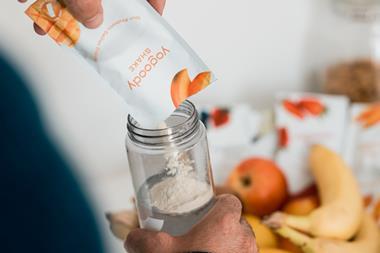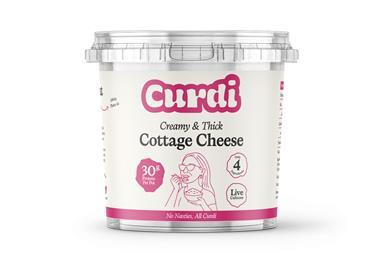Huge EU stockpiles are supposed to be a thing of the past. But just two years after it was levelled, the butter mountain is back and is set to top 100,000 tonnes before the end of the year.
The European Commission stepped in at the beginning of the year after a huge crash in wholesale prices and consumer demand. It is confident demand will return swiftly and the dairy sector support will be short term. Taxpayers, who have paid more than 600m since January to fund subsidies and stockpiling, will certainly be hoping so. But experts warn that the butter mountain could keep growing for another five years.
So just how long will it last this time around?
Despite the fanfare that greeted the disappearance of the butter mountain in 2007, the circumstances that led to its demise may have been a one-off, says Provision Trade Federation dairy specialist Mike Bessey. "In 2007, dairy prices escalated to unprecedented levels and shortages led to stockpiles diminishing very quickly," he says. "As you would expect, these high prices damaged demand. This has now been aggravated by recession and prices have plummeted, so the EU has had to intervene."
As retail prices have not fallen nearly as much as wholesale markets, demand has not been stimulated by lower prices, leaving the EU with considerable oversupply of many key dairy lines, he adds.
Commodity and sector analysts do not expect a recurrence of 2007's dramatic price spikes, so the butter mountain might be here for the long term, Bessey warns.
"It's not hard to imagine us stuck with intervention buying for at least the next three to five years," he says. "The Commission has a delicate balancing act: it doesn't want to spend too much on subsidies and stockpiles, but it can't let too many dairy farms collapse, especially in Continental Europe where pressure is tougher."
The challenge for the EU is finding a level of intervention that neither upsets too many people nor costs too much. Despite agreeing to buy up just 30,000 tonnes of butter and 109,000 tonnes of skimmed milk powder this January, the EU has already stockpiled 82,000 tonnes of butter and more than 200,000 tonnes of skimmed milk and has agreed to purchase more until February 2010 at the earliest.
Subsidising the sale of EU butter to other countries, which supports farmers while avoiding stockpiles, can upset foreign governments whose own farms are put at risk. This can lead to 'tariff wars' and other trade disputes. Intervention buying up butter at a guaranteed minimum price is therefore the most palatable option.
"Intervention will go on as long as needed," says Mark Voorbergen, Rabobank's senior dairy analyst. "By extending the normal period it gives a clear signal it will continue as long as possible. There are proposals to look at demand programmes to subsidise the use of butter and skimmed milk powder in other products, schemes that were abandoned in 2006. It's about creating artificial demand."
UK farmers are in a stronger position than many in Europe, but UK and European prices are strongly correlated due to the internal market, Voorbergen points out.
UK milk supply is tighter than elsewhere, and this coupled with sterling's sharp fall in value means UK farmers have faced price falls of around just a third of those of their Continental counterparts. But while oversupply remains in Europe, UK prices will be pushed down, analysts warn.
The EU might be keeping its fingers crossed that the new butter mountain is short-lived, but unless consumer demand for dairy recovers, or more farmers give up the trade, it will keep on growing.
The European Commission stepped in at the beginning of the year after a huge crash in wholesale prices and consumer demand. It is confident demand will return swiftly and the dairy sector support will be short term. Taxpayers, who have paid more than 600m since January to fund subsidies and stockpiling, will certainly be hoping so. But experts warn that the butter mountain could keep growing for another five years.
So just how long will it last this time around?
Despite the fanfare that greeted the disappearance of the butter mountain in 2007, the circumstances that led to its demise may have been a one-off, says Provision Trade Federation dairy specialist Mike Bessey. "In 2007, dairy prices escalated to unprecedented levels and shortages led to stockpiles diminishing very quickly," he says. "As you would expect, these high prices damaged demand. This has now been aggravated by recession and prices have plummeted, so the EU has had to intervene."
As retail prices have not fallen nearly as much as wholesale markets, demand has not been stimulated by lower prices, leaving the EU with considerable oversupply of many key dairy lines, he adds.
Commodity and sector analysts do not expect a recurrence of 2007's dramatic price spikes, so the butter mountain might be here for the long term, Bessey warns.
"It's not hard to imagine us stuck with intervention buying for at least the next three to five years," he says. "The Commission has a delicate balancing act: it doesn't want to spend too much on subsidies and stockpiles, but it can't let too many dairy farms collapse, especially in Continental Europe where pressure is tougher."
The challenge for the EU is finding a level of intervention that neither upsets too many people nor costs too much. Despite agreeing to buy up just 30,000 tonnes of butter and 109,000 tonnes of skimmed milk powder this January, the EU has already stockpiled 82,000 tonnes of butter and more than 200,000 tonnes of skimmed milk and has agreed to purchase more until February 2010 at the earliest.
Subsidising the sale of EU butter to other countries, which supports farmers while avoiding stockpiles, can upset foreign governments whose own farms are put at risk. This can lead to 'tariff wars' and other trade disputes. Intervention buying up butter at a guaranteed minimum price is therefore the most palatable option.
"Intervention will go on as long as needed," says Mark Voorbergen, Rabobank's senior dairy analyst. "By extending the normal period it gives a clear signal it will continue as long as possible. There are proposals to look at demand programmes to subsidise the use of butter and skimmed milk powder in other products, schemes that were abandoned in 2006. It's about creating artificial demand."
UK farmers are in a stronger position than many in Europe, but UK and European prices are strongly correlated due to the internal market, Voorbergen points out.
UK milk supply is tighter than elsewhere, and this coupled with sterling's sharp fall in value means UK farmers have faced price falls of around just a third of those of their Continental counterparts. But while oversupply remains in Europe, UK prices will be pushed down, analysts warn.
The EU might be keeping its fingers crossed that the new butter mountain is short-lived, but unless consumer demand for dairy recovers, or more farmers give up the trade, it will keep on growing.



















No comments yet